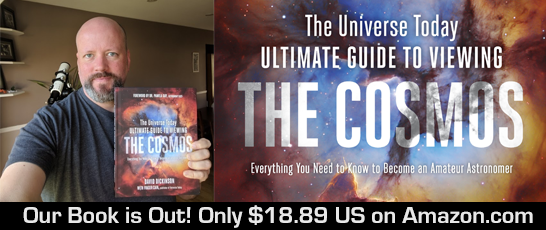At the time I'm finishing this newsletter, Jessica Meir and Christina Koch just wrapped up the first all-female spacewalk in history. Of course, this should have happened earlier this year, but there weren't enough properly-sized spacesuits on board the International Space Station. It looks like everything is going great up there in orbit. This week is memorable for spacewalks in another way too. For a sadder reason. The first person to ever perform this feat was cosmonaut Alexei Leonov, stepping out of his space capsule in 1965, and demonstrating that humans can really work in the harsh environment of space. Sadly, Leonov passed away this week, at the age of 85. Congratulations to Meir and Koch! I'm sure Leonov would be pleased to see how routine spacewalking has become.
The First All-Female Spacewalk is a Success!
Thanks!
Fraser Cain
Publisher
Universe Today
As always, if you have comments or questions, or suggestions on how I can improve this newsletter, please don't hesitate to reply this email or email me at info@universetoday.com.
Patrons, don't forget to login to Universe Today. That'll remove all the ads for you. Join the 833 Patrons who get our videos early, see behind the scenes, and get no ads on Universe Today.
AstroClipper: Plans for a Two-Stage, Fully Reusable Spaceplane
Even as the first rockets were launched into space decades ago, aerospace knew it was a wasteful process. Rocket stages, motors, and complex equipment crashed into the ocean or burned up in the Earth's atmosphere. Could spaceplanes bring the costs down? Flying to orbit with a combination of jet engines and rockets and then safely re-enter the Earth's atmosphere again. Single-stage to orbit spacecraft and spaceplanes have always seemed out of reach, and actually not that practical. But what about a two-stage, fully reusable spaceplane? Exodus Space Corporation has been secretly working on this concept for a decade now, and what they're proposing is pretty revolutionary.
Subscribe to our podcasts:
Universe Today Guide to Space Audio: iTunes - RSS
Audio versions of all the media I upload to my YouTube channel, as well as bonus content, behind the scenes, interviews with Fraser and more
Astronomy Cast: iTunes - RSS
Your weekly facts-based journey through the cosmos, which I co-host with astronomer Dr. Pamela Gay. We have episodes on every concept in space and astronomy, from black holes to the history of astronomy.
Weekly Space Hangout: iTunes - RSS
A weekly round-up of all the breaking space news. Rocket launches, new discoveries from Hubble, and planetary science by three PhD astronomers... and me.
It Looks Like it's Working! NASA InSight's Mole is Making Progress Again Thanks to the Arm Scoop Hack
NASA's InSight Lander has been trying to take the temperature of Mars, to figure out how much its interior has cooled down. But the temperature probe it was using got stuck just a little down in the regolith. Engineers thought it might be a rock, but a hack to pin the probe against the side of the borehole seems to be working and the probe is making progress going deeper again.
Robotic Spiders to Explore the Moon? Yes, Please!
When Astrobiotic's Peregrine Lander flies to the Moon in 2021, it's going to be carrying a unique 4-legged spider bot on board. Built by SpaceBit, this Walking Rover will be able to shuffle around on the surface of the Moon, helping to explore the terrain around the landing site. It could even be used to explore lava tubes and other features that might be difficult to visit with a wheeled rover.
NASA Engineer Has A Great Idea for a High-Speed Spacedrive. Too Bad it Violates the Laws of Physics
NASA engineer David Burns recently posted an idea for a space drive that could carry a spacecraft to relativistic speeds. Unfortunately, there's also no way it could work, because it violates the laws of physics as we understand them. In theory, it would take advantage of the fact that particles can be more massive when you accelerate them to nearly the speed of light in a particle accelerator.
Planet Sizes Matter for Habitability Too.
We've talked quite a bit about the habitable zone around stars, a region where liquid water can be present. But it also looks like the mass and size of the planet is important too. Larger planets like Earth, Venus and even Mars are okay, but once the world gets smaller, like the size of Ganymede or the Moon, it doesn't have enough gravity to hold onto its water.
SpaceX Files a Request to Launch Another 30,000 Satellites for Starlink, on Top of the 12,000 They're Already Planning to Launch
Remember when SpaceX announced they were going to launch 12,000 satellites as part of the Starlink constellation? How quaint. Earlier this month, the company announced that they want to loft an additional 30,000 satellites into a variety of orbits, bringing the total to 42,000. Obviously this has serious implications for ground-based astronomy, trying to peer through clouds of satellites.
Space Is Hard
Just in case you weren't sure, NASA wants to remind you that space is a hostile, unforgiving environment. Space is hard. Here's a short video with cool graphics, thrilling music and super slo-mo shots of astronauts suiting up for the final frontier. They'd like you to know they've never been more ready to meet the unknown, and they will succeed.
An Army of Tiny Robots Could Assemble Huge Structures in Space
Whenever you launch structures into space, you're limited by the size of the rocket fairing, and the challenging origami it takes to unfold a satellite. But what if you could just launch all the raw materials and then let robots construct it part by part as big as you need? Researchers from MIT demonstrated how an army of tiny robots could manufacture space-based structures of unlimited size.
Here's the Picture We've Been Waiting for. Hubble's Photo of Interstellar Comet 2I/Borisov
Now that we know that another interstellar object is making its way through the Solar System, astronomers have been scrambling to point every single observatory on Earth at the object. And now the mighty Hubble Space Telescope has joined in, capturing this image of Comet 2I/Borisov. One of the biggest surprises is how similar this comet is our own Solar System's comets.
Virgin Galactic and Under Armour Reveal Spacewear Clothing Line for Suborbital Trips
NASA wasn't the only one revealing their spacesuits this week, Virgin Galactic made their reveal as well. If you take a sub-orbital hop in one of their SpaceShipTwo rockets, you'll be sporting this stylish blue Under Armor flightsuit and zipper boots as modeled by Richard Branson and his friends. The next time he puts this on, said Branson, he'll be on his way to the edge of space.
There's the Curiosity Rover, on the Move, Seen from Space
NASA's Mars Reconnaissance Orbiter is currently orbiting the Red Planet, capturing the world in incredible detail. And every now and then, the spacecraft takes a moment to check in on the various landers and rovers down on the surface of Mars. In this photograph you can see the Curiosity Rover crawling along the base of Gale Crater, searching for past evidence of water on Mars.
Good News, Astronomers Found Planets Similar to Earth. Bad News, it's Actually the Rubble of Dead Planets, Orbiting Dead Stars
Astronomers just found compelling evidence that there are other planets out there with very similar chemical signatures to Earth. Unfortunately, they found these clues in the smashed up debris of planets orbiting a bunch of white dwarf stars - remnants of stars like our Sun which ran out of fuel and died. But back in their day, these planets would have had rock and metal in simlar quantities to Earth.
NASA's New Lunar Spacesuit is Going to be a Lot More Comfortable for Astronauts
It's been almost 50 years since the last astronaut left the Moon during the Apollo missions. And now that astronauts are going to be returning with the Artemis program, they're going to need spacesuits packed with modern technology and all the hard lessons learned from last time people flew to the Moon. This week NASA unveiled their new spacesuits using astronauts as models.
Other Interesting Space Stuff
- A Satellite Just Launched Whose Job is to Extend the Life of Geosynchronous Satellites
- OSIRIS-REx sees Earth from 100 million kilometers away
- This Dried Up Riverbed Shows that Water Once Flowed on the Surface of Mars
- There could be multiple sources creating deposits of water at the Moon's south pole
- The path the Artemis mission will take to the Moon
- This is really cool! How The Visually Impaired Experience Hubble Images
- NASA Has a New, All-Electric Airplane
- Asteroid photobombs a Hubble photo of the Crab Nebula
- Galaxy cluster used as a lens to observe a tiny dwarf galaxy much farther away that's awash in star formation
- Supermassive black hole has multiple disks of gas bringing in material for it to feast upon
- How to Safely Photograph the Sun (and the Transit of Mercury)
- Scientists think they finally understand why Galileo's entry probe burned up so quickly in Jupiter's atmosphere
- Mars' Gale Crater was once filled with ice-covered lakes. This could have been an ideal place to sustain life on the hostile planet
Amazing Astrophotography on @universetoday
Globular Cluster 47 Tucanae
This is the globular cluster 47 Tucanae (NGC 104), the second brightest in the night sky after the Omega Cluster. Globular clusters are some of the oldest objects astronomers know of, forming shortly after the Universe itself. It was captured by @torbensimm_astrophotography
We have featured over 1,000 astrophotographers on our Instagram page, which has more than 186,000 followers. Want to do a takeover? Use the hashtag #universetoday and I'll check out your photos.
Find your way across the night sky. Choose a variety of astronomy gear. Follow the Moon and the planets. Find deep sky objects across the seasons in both hemispheres. Observe comets, asteroids, satellites and space stations. Learn to do astrophotography.
Get it on Amazon for only $18.89. Here are some other options.
|



No comments:
Post a Comment